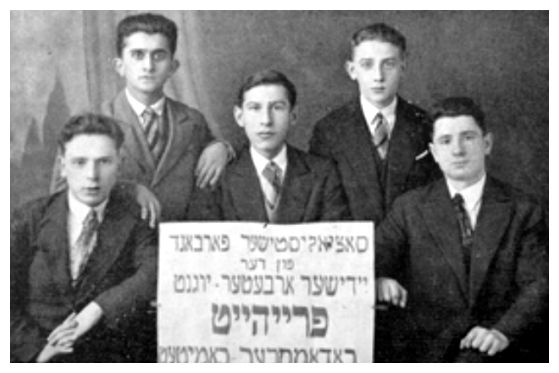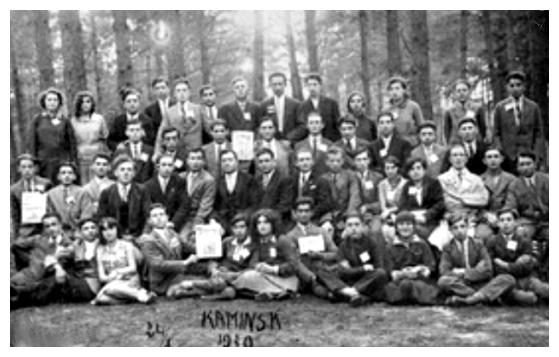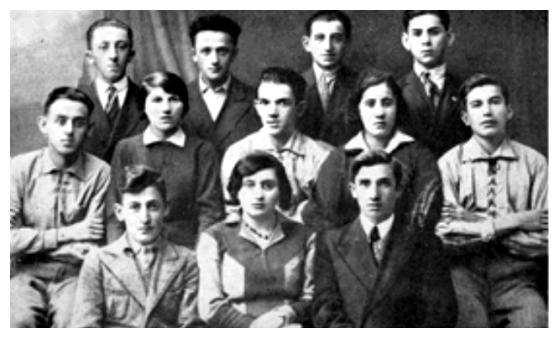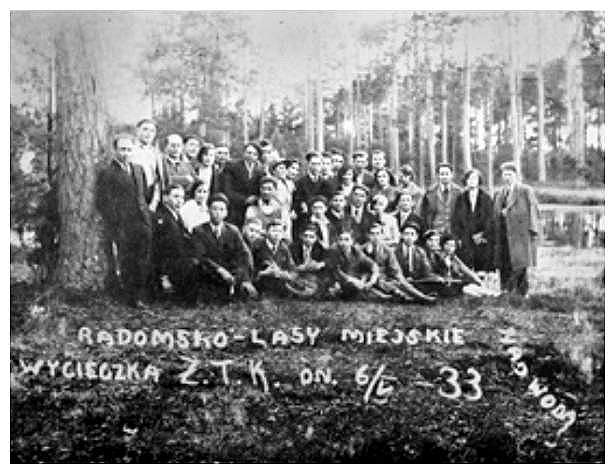
From the right: Yerakhmiel Herbert, Tuvia Borzykowski, Yehezkeil Skornicki, Tuvia Mandel, Dovid Wadislawski
|
by Y. Sh. Moszkowicz and Shimshun Granek
Translated by Gloria Berkenstat Freund
Freiheit arose as a result of the union of the Jewish Socialist Worker Youth
(Y.S.A.Y.) of the right wing Poalei-Zion and the Zionist Socialist Youth of
Z.S. (Zionist Socialists). The unification conference took place in Warsaw in the
month of December 1926 – one year after the unification of both parties.
Berl Loker, representative of the World Union of P.Z. (Z.S.) and A. Cyzling, emissary of the Histadrut and he-Halutz in Poland, took part in the youth conference. Our delegate to the conference was Yehuda Liberman.
The right wing Poalei-Zion had no youth group in Radomsk. The Z.S., on the other hand, had a large youth group, which immediately joined Freiheit and became very active there. The majority of the members of the group lived in Atzkawski's house on Shul Street. There was Yakov and Ruchl Liberman, Dovid and Leah Wadislawski, Asher and Nusen Grosman, Yehezkeil Cukerman and others. With the creation of Freiheit, new members joined, such as Tuvia Borzykowski, of blessed memory, Abraham Goldberg (now a member in Kibbutz Shfaim), the brothers Abraham and Tuvia Mandel, Yakov-Shmuel Moszkowicz (now a member of Kibbutz Ein-Carmel), Yehezkeil Skornicki and many others.
The new youth organization began its activities with a recruitment campaign by its members. Many young workers and children from poor homes, sons and daughters of tradesmen and small businessmen, who needed to help out their parents by earning a living from early until late at night, joined as members of Freiheit. The organization placed the most importance on educational and cultural work. Whereas many young people did not even have an elementary education, the goal was to educate the young in the light of the ideals of Zionism and Socialism, in the spirit of the Halutzisher youth movement whose purpose was preparatory agricultural training for emigration to Eretz-Yisroel and aliyah.
The educational work was directed by the Freiheit members M.Z. Rozenblat, Arya Cipler, Yehuda Liberman, Haim Goldberg, and others, who carried out a systematic series of lectures about real questions. Later, Professor Izrael Bramberg enlisted in the educational work.
The creation of the Sholem Aleichem Library significantly enriched the knowledge of the young – Freiheit members were the most dedicated readers in the library and many helped in its development.
 |
| The committee of “Freiheit”
From the right: Yerakhmiel Herbert, Tuvia Borzykowski, Yehezkeil Skornicki, Tuvia Mandel, Dovid Wadislawski |
[Page 220]
In the summer months, outings in the nearby woods were arranged every Shabbos;
there, songs from Eretz-Yisroel were sung, the hora was danced and real
problems were discussed.
 |
|
“Freiheit” conference dedicated to the activity of Keren Kayemet
L'Yisroel, taking place in Kamiensk (in 1930), with the participation of Abraham Bialopolski (Central Committee)
Top row: Yehezkeil Dikerman, Fiszman, Brocha Grosman, Kos,
Second row: B. Sztajn, Birncwajg, Y. Brener, Y. Herbet, Yakov Wengligski,
Szklarczyk, Berl Kuperwaser, Abraham-Mendl Fiszlewicz.
Third Row: Rozenblum, Moishe Wajnman, Tajchner, Sara Dawner, Hana Gelbard,
Bottom: _____, _____, _____, Dawidowicz, F. Hirszberg, Tuvia Mandel, Ruchl
Liberman, Rozenberg, Szklarczyk, _____, Aliezer Haptman, Fiszel Zandberg |
 |
|
A group of “Freiheit” members before leaving as “hachshara”
(agricultural trainees)
Top row (from the right): Yosef Liberman, Shimshun Granek, Fiszel Zandberg,
Abraham Tajchner
|
The youth organization Freiheit constantly received new members and became
the defensive wall against communist agitation that planted hatred among the Jewish
youth against national revival in Eretz-Yisroel. It is worthwhile to remember
that at that time an anti-Zionist mood reigned in Radomsk, which was brought by the
Israeli expatriates from the 4th aliyah, who returned “home”
and spoke ill of Eretz-Yisroel. As a result of this, the local Zionist parties suspended
their activities and there remained individuals who persevered in the Zionist framework.
There was almost no one to oppose the anti-Zionist activity. The youth organization Freiheit
together with the party and he-Halutz were the only ones in the city carrying out strong
activity against the “red” assimilation and salvaged from their influence hundreds of
young people who lived to see themselves immigrate to Eretz-Yisroel.
The enlightened activities advanced further with each year and included wider areas of Zionist and socialist life in Eretz-Yisroel. Simultaneously, every year Freiheit would take part in the international workers' holiday on the 1st of May. Weeks earlier the meaning of the holiday would be discussed at special meetings, workers' songs were learned, posters and billboards were prepared, there were lively discussions and agitation among the Jewish youth urging them to participate in the First of May demonstrations.
Sometimes the workers' demonstrations on the 1st of May were held jointly with the other Jewish and Polish workers' parties and sometimes each party demonstrated separately. The demonstrations of the united Poalei-Zion-Z.S. Party always focused on Zionist-Socialist groupings – in addition to the members and followers of Freiheit, the members of he-Halutz, of the League for Workers in Eretz-Yisroel, later from Haoved (labor faction within the Socialist-Zionist camp) and of the professional unions that were under the influence of the party. These demonstrations were the largest and were better organized than those of the other demonstrating groupings.
Freiheit members participated very actively in the work of K.K.L. and in all of the other actions and money collections. Freiheit occupied the first spot, after the K.K.L. battalion, in arranging bazaars, flower days, and other undertakings, among the Radomsker youth organizations in participation in the actions of K.K.L. The permanent Freiheit representatives on the committee of K.K.L. were the members Y. Skornicki, M. Grosman, A. Cipler, Y. Birnbaum, Y. Granek, L. Houptman, Kh. Cukerman and others.
For the election to the Zionist Congress, Freiheit distributed many shekels and at the clarification meetings that the organization carried out, the party members A. Bialopolski, of blessed memory, Anshel Rajs, L. Szpisman, Y. Ritaw, Leizer Lewin, and others participated. The meetings were a great success and brought good results during the voting.
After several years of education work, at the beginning of 1930 the Freiheitist's Hachshara
(agricultural training) began and later their aliyah to Eretz-Yisroel.
[Page 221]
The first members who traveled to Hachshara were Y. Sh. Moszkowicz,
(now at Kibbutz Ein Hacarmel), T. Mandel, B. Sztajn, Y. Fajerman, A. Dimant,
Manele, Houptman and many others. The Hachshara locations for our
members were Kleszczow, Gorzkow, Borokow Kibbutz in Lodz and Będzin.
In 1931 a number of members made aliyah, in spite of the closed doors of Eretz-Yisroel. Banquets were held in honor of the aliyah of these members, at which we touchingly took leave of those departing.
Every year members of Freiheit would join the party. These were august moments and always took place in a joyful manner and at a special meeting. The first such gathering took place in 1931 when the comrades Skornicki, Borzykowski, Grosman, Widislawski, Yakov Liberman and others joined the party. The new party members were welcomed by Haim Goldberg, Yehuda Liberman and others. In 1933 the Comrades Granek, Kuperwaser, Birnbaum, the Mandel brothers and others joined.
Such celebrations were also held in subsequent years and the new members took the place of the old members who made aliyah to Eretz-Yisroel or undertook other important party positions.
The members of Freiheit, in agreement with their active Zionist-Halutzisher activities, helped the party in its local political activities, such as voting for the City Council, Kehile, and the like.
Thirty-eight members from Radomsk took part in the Freiheit organization meeting for the Lodz region that occurred in April 1930. Year in and year out, Freiheit arranged summer camps for the members, who benefited greatly from this.
In 1931 the organization Freiheit in Radomsk arranged a solemn academy for its 5th anniversary at which Z. Szerf from Eretz-Yisroel, H. Goldberg, Yehuda Liberman, Sh. Najman, Yakov Liberman, a representative of Tur and youths from the Polish Workers' Party, P.P.S., and others appeared on stage with welcoming remarks.
The members of Freiheit were very active in the creation of the sport club Hapoel and were the most active members of the different sports sections as well as in the dramatic section.
The club carried out effective activities and was located in a large beautiful meeting hall near the Kino. Four men's groups and five women's groups were active in the club, which exercised under the direction of the instructors Dovid Wielunski and Mundek Fajerman (both had completed special courses as exercise instructors).
The club had a strong ping-pong section that was the runner-up in the Czenstochower league, a fairly good football section that achieved several victories over various football clubs and was champion of the Hapoel clubs in the Lodzer circle.
The celebration of the international youth day in November 1936 turned out to be very impressive.
In 1937 Freiheit arranged an exhibition of the works of the members that included painting, knitting, carving wooden models, cabinet making, metal work, tailoring and the like. The exhibition, which made a colossal impression, was accompanied by lectures, academies, and so forth. In 1938 the merger of Freiheit and he-Halutz-Hatzair took place.
Thus evolved the young in Radomsk in the Halutzish-Zionist ranks of Freiheit until – until the coming of the dark tragic days of September 1939, when the murderous German bands spread death and Holocaust.
After the first month of penal-life in the Radomsker ghetto, Comrade Tuvia Borzykowski, the Freiheit coach and teacher, decided to create the first underground group of Jewish youth in Radomsk, without any connection with other cities in Poland, and without the Center in Warsaw.
The members of Dror-Freheit were those who created the first four groups of five members as the nucleus of the Jewish underground to struggle against the Germans. The first meeting of the four “fifths” took place in the home of the veteran of the rightist Poalei-Zionist Comrade Mordekhai Zelig Rozenblat.
 |
|
Members of Freiheit and he-Halutz during the leave taking of
Yakov-Shmuel Moszkowicz before his aliyah to Eretz-Yisroel (1931)
Top row (from the right): Fishel Zandberg, Haim Klajner, Pinye Herszberg, Yakov
Lakhman,
Second row: Fishel Zajdman, Tzvi Cipler, Sara Fiszman, Shimkah Rajkh, Sara
Gelbard, Sh. Tajchner,
Third row: Moishe Brener, Wolf Brener, Ahron Fiszlewicz, Tuvia Borzykowski,
Haim Goldberg, Yehuda Liberman,
Fourth row: Abraham Dikerman, A. Tajchner, _____, Yakov Gotesman, _____, Ruchl
Liberman, Sara Najman, Szklarczyk, _____, Moishe Liberman.
Fifth row: Hana Ofman, _____, Cipler, G. Szerman, A. Szerman, Gitl Widislawski,
Abraham Birnbaum, |
by Hillel Fachter
Translated by Gloria Berkenstat Freund
Outwardly, our city had the look of a grey, quiet Jewish settlement, absorbed
only with earning a living. However, there were moments when the community
emerged from its day-to-day routine and demonstrated that there beat in it a
fiery Jewish heart.
One of those moments was a hot August evening in 1929. Dozens of Jews had assembled at the train station, respected businessmen and ordinary young men. They had not agreed to meet prior to arriving; they had not organized themselves. They came here spontaneously in order to wait for the train that would arrive from Warsaw. The morning newspaper had reported that a large group of Halutzim (pioneers) were departing from Warsaw for Eretz-Yisroel after noon. And it was understood that that meant the express train that passes through Radomsk at ten o'clock in the evening. That is, it would be possible to tell the pioneers, “ fort gezunterheit ” (travel in good health) and accompany them with a blessing on their way to the homeland.
The small Jewish population in Palestine was once again enveloped in flames and making a sacrifice in order to preserve what has already been achieved. Now young men traveled there to strengthen the line of fighters and drill in the Jewish homeland. Therefore, they needed to be accompanied by everyone's blessing.
The train comes in, a red glow from the large round lanterns approaching and cutting through the darkness of the night. And there is something symbolic in the redness of the lights that light the dark surrounding fields… In the dark, young men can be seen on the train, the beaming faces of the Halutzim. In their hands flutters the blue and white flag. Those assembled look at them with pride and with envy. They are traveling to struggle and to build, and every one of their hearts is filled with the belief that they will see with their own eyes the liberated Jewish nation. The singing of Hatikvah broke out from our hearts and overwhelmed the noise of the departing train.
Late, after half the night had passed, those of us gathered at the train station dispersed. There was a heavy feeling in our hearts, a longing and envy, but simultaneously, there also ripened a passionate desire to free ourselves of our chains of exile and follow the Halutzim, in order to build that new life in our old new-home, together with them, hand in hand.
Flyer:
|
by D. Al-Kh
Translated by Gloria Berkenstat Freund
In 1934 a group of friends, originally from Radomsk and Czentochow, organized
an Aid Committee in America to assist the political prisoners from those
cities. The Radomsker committee, which was named the Nowo-Radomsker Patronat
was made up of the following members Dave Lefkowicz, Simeon and Frimet
Medvjed, Abe Rozenberg, Ezekiel Pacanowsky, Leibel Gelbard, Abe Oberman, Sam
Dikerman, Sam and Jeanette Freilich, Harry and Ruchel Jacobs, Sadie Laglere,
Israel Buchman, Leibel Goldberg, Harry Rudnitsky, Philip Lager, Harry
Sedletsky, Solomon Waksman, Max Szpira, Mike Brader, Jack Schwartz, Bela
Schwartz, Pinkus Kalka, Harold Pinkowicz, and Jack Besterman.
From the material that the Nowo-Radomsker Patronat published in America, we get a glimpse into its character, aims, publications and accomplishments. The Patronat was considered an instrument in the struggle against Polish “reaction,” which through its anti-Semitic policies of rooting out the opposition and through terroristic laws, took away the right and the ability of the broad Jewish masses in Poland to exist.
True, the Polish multitude were also victims of the “reaction.” Their
standard of living was lowered. However, when times were perilous for the
Polish reactionary government, it applied the old Czarist methods of agitation
against the Jews and, following the usual practice, blamed the Jews for the
critical situation. In that way, the government would divert the attention of
the Polish masses and turn their fury in another direction.
[Page 223]
The progressive elements in Poland, Jews and non-Jews, who dared to stand
against the ruling circles, with complaints and protests against their actions,
were ruthlessly oppressed with force. They were thrown in jail or interned in
special isolation camps. According to a general estimate by the above mentioned
Patronat for the years 1934-1935, approximately 50,000 people were arrested or interned
in Poland, in 364 jails and camps. All of those who dared to complain or
protest against the regime were prosecuted according to the paragraphs of the
legal code concerning anti-state or Communist activities, although not all of
those sentenced were necessarily active Communists.
Among the Radomsker youth who were sentenced to prison by the local county court (in 1934) were Hershel Witenberg, Sheike Rozenblat, Roiza Saletski, and Liobe Rozenbaum (to 4 years); Leibish Rozencwajg, and Mietuk Kazak (to 3 years); Dovid Bugajski and Leyzer Kalka (to 2 years); Meir Goldsztajn (1 ½ years), a total of 9 young people.
In 1934, there were 86 members of the Nowo-Radomsker Patronat. The Aid Committee sent material support to Radomsk, food and clothing for the city's political prisoners and their families. The activity of this Aid Committee was carried out with the massive support of the general landsmanschaft- society of the Radomskers in America, and had a positive effect on the working circles and among the masses in Radomsk proper.
A message released by Nowo-Radomsker Patronat during a banquet of the general Nowo-Radomsker 'Relief' in New York (February 1937) said:
|
“Worthy friends!” The Jewish tragedy in all of Poland has reached a point
that cannot be worse and has already penetrated throughout Jewish life. There
is no limit to the wild barbarism, the reckless situation and the openly brutal
pogroms. The ordinary Jew is deprived of his livelihood; milk sellers,
butchers, bakeries and Jewish workers are thrown over the precipice. Jewish
students are thrown out of the secondary schools, bloodied and insulted, and
they are not permitted to fulfill their long held hope of becoming doctors, or
entering other intellectual professions. And how can one, worthy friends, in
such a bloody nightmare, free oneself from the painful feeling of many empty
hopes, at a time when our sisters and brothers bathe themselves in a sea of
distress and need, and no one does anything?
“Dear friends! We appeal to you, help us in the sacred work! We must be united against such a mighty foe! Join with all the members of the Nowo-Radomsker Patronat, while we redouble our assistance work; do not stand as a spectator at a distance in such a solemn historic moment. Become one of the activists in this virtuous aid work. With it, you will stimulate your human spirit to help relieve the pain of the political prisoners and their families, who give their young lives for the suffering of the Jewish people.” |
 |
| Z. T. K. – Jewish Society of Nature Study established by the members of the
Communist Party, during an outing in the city woods (May 6th, 1933)
Standing (from the right); M. Meitlis, ______, Fiszelewicz, D. Bugajski, S.
Krakowski, A. Witenberg, Kh. Kahen,
|
by “Gimel. Hay. (Gadol Hador – leading figure of his generation)”
Translated by Gloria Berkenstat Freund
In Israel a murderous hand interrupted the rich active life of our
unforgettable leader Dr. Haim Arlozoroff.
The 18th Zionist Congress, desiring to perpetuate the memory of our tragically murdered leader, had decided to create in Eretz-Yisroel a large colony in his name, on which will be settled some hundred families including German Jews.
The local Arlozoroff Committee has decided to begin the solicitation this week, and for that purpose our representative will call upon you in the coming days and we ask that you give a proper donation.
In the name of Arlozoroff Work Committee:
… The Zionist Organization:
Dr. Y. Aranowicz, Josef Zeligzon, Yakov Szpira
… Y. S. A. F. 'Poalei Zion' (with Z. S.)
Wolf Szpira, Moishe Szitenberg, Yekheskel Skurnicki
…The Keren Kayamet Commission
Chaim Hartman, Abraham Ajzen
… heHalutz
B. Kuperwaser, Oberzanek
…The League for Work. Eretz-Yisroel
Leman, Feiwel Lorye
… Y.A.S.K. Hapoel
L. Szpira, Y. Cipler
… Freiheit Organization
Sh. Granek, A. Dikerman
… Hanoar-Hazioni
Yisokhar Minski, M. Tiger
… Gordonya
H. Ofman, R. Warsawski
| Radomsk, November 1933 |
|
JewishGen, Inc. makes no representations regarding the accuracy of
the translation. The reader may wish to refer to the original material
for verification.
JewishGen is not responsible for inaccuracies or omissions in the original work and cannot rewrite or edit the text to correct inaccuracies and/or omissions.
Our mission is to produce a translation of the original work and we cannot verify the accuracy of statements or alter facts cited.
 Radomsko, Poland
Radomsko, Poland
 Yizkor Book Project
Yizkor Book Project
 JewishGen Home Page
JewishGen Home Page
Copyright © 1999-2026 by JewishGen, Inc.
Updated 28 Oct 2025 by LA